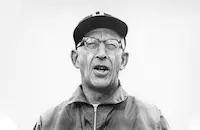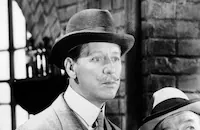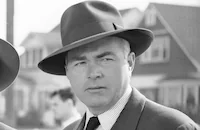Blondie

Brief Synopsis
Cast & Crew
Frank R. Strayer
Penny Singleton
Arthur Lake
Larry Simms
Daisy
Gene Lockhart
Photos & Videos
Film Details
Technical Specs

Synopsis
On the eve of their fifth wedding anniversary, Blondie and Dagwood Bumstead, and their child Baby Dumpling, are in financial trouble. Blondie presses Dagwood to ask his boss Mr. Dithers for a raise because she has purchased a new set of living room furniture on credit as a surprise. Unfortunately, when Dagwood arrives at the construction company where he works, he discovers that he is being held responsible for repayment of a loan note he approved for Mr. Dither's former secretary, Elsie. Anxious to cover the loan, Dagwood begs Mr. Dithers for a raise. Hardhearted Dithers refuses, but agrees that if Dagwood can make a sale to salesmen-phobic C. P. Hazlip, he will give him the raise and a bonus to cover the note. At the hotel, a smug desk clerk tells Dagwood that Hazlip is out, so he sits down to wait. Actually Hazlip is in the hotel, sitting right next to Dagwood. The two men are drawn together by a mutual love of tinkering, and together they work all afternoon trying unsuccessfully to fix a vacuum cleaner. Finally, Hazlip's daughter Elsie arrives and Dagwood finds out that his tinkering buddy is actually his sales target. Just as it seems everything will work out, Blondie erroneously thinks that Dagwood is having an affair with someone named Elsie, Dithers fires Dagwood because he hasn't made the sale, the loan company repossesses the new furniture, and Dagwood is accused of stealing his mother-in-law's car when he borrows it to beg Hazlip to explain the situation to Blondie. Hazlip and Dagwood spend the night in jail, and the next day in court, Blondie straightens out the whole mess. When Hazlip gladly offers his business to Dagwood, Blondie uses this lever to negotiate a new and substantially better work deal for Dagwood.

Director
Frank R. Strayer
Cast

Penny Singleton
Arthur Lake
Larry Simms
Daisy

Gene Lockhart

Jonathan Hale

Gordon Oliver
Danny Mummert
Kathleen Lockhart

Ann Doran
Dorothy Moore

Fay Helm

Willie Best

Ian Wolfe
Richard Fiske
Stanley Andrews

Charles Lane
Hal K. Dawson
Walter Soderling
Hooper Atchley

Irving Bacon
Emory Parnell
Edgar Dearing
Harold Minjir
Eugene Anderson Jr.
David Newell
Bud Jamison
Chuck Hamilton

James Flavin
John Rand
George Humbert
Bruce Sidney
Josephine Whittell
Dick Curtis
Crew

Photo Collections
Film Details
Technical Specs

Articles
Blondie
Frank R. Strayer directed from a script that was originally set to be adapted by Aurania Rouverol, but was eventually written by Richard Flournoy. Many cast changes were made in pre-production. Blondie was going to be played by Gloria Blondell, sister of Joan Blondell, then Una Merkel was to star with Stuart Erwin as Dagwood. According to the American Film Institute, Shirley Deane had been cast, but illness prevented her from playing the role. Blondie finally went to Penny Singleton, who had been in films for years as a brunette under her real name of Dorothy McNulty, including a bit part in After the Thin Man (1936). Singleton would bleach her hair to play Blondie, and her co-star for all twenty-eight films was character actor Arthur Lake.
The film went into production on September 12, 1938 and lasted less than a month, wrapping on October 7th. In the cast were veteran character actors Gene Lockhart as C.P. Hazlip and his real-life wife, Kathleen Lockhart as Blondie's mother, Jonathan Hale as Mr. Dithers, and young Larry Simms as Baby Dumpling. Simms would stay with the series until the end, with his character evolving from "Baby Dumpling" to Alexander Bumstead. The film version of Blondie makes a major change to the storyline of the comic strip. Blondie and Dagwood became high school sweethearts instead of a flapper and a disinherited playboy, which was more in line with the values of Depression-era America. The film opens with the Bumsteads celebrating their fifth wedding anniversary and, like many families in the 1930s, short on cash. Blondie presses her husband to ask his boss, Mr. Dithers, for a raise to pay off the new living room set she bought on credit. When Dagwood arrives at work, he learns that the loan he co-signed for Dithers' former secretary has come due and he is now responsible. While Dithers won't give Dagwood a raise, he promises that he will both pay the loan and give Dagwood the raise if he can convince Hazlip to use their company for a construction project.
Blondie was a surprise hit and the studio decided to turn it into a series, but after five years, Columbia had grown tired of the Bumsteads. The audience's negative response to the cancellation was so strong that the studio was forced to bring it back. The Blondie series would continue until 1950, when Columbia could not agree on a new licensing contract with King Features. Blondie had another life on radio, with Lake and Singleton reprising their roles from 1939 until 1949 when Singleton left the radio show. Alice White, Ann Rutherford, and Lake's real-life wife, Patricia van Cleve, would replace her. The Bumsteads appeared on television in three separate series in 1954, 1958, and 1968-69, with Lake playing Dagwood with Pamela Britton as Blondie in the 1958 series. When her time as Blondie was over, Singleton became a union activist for the American Guild of Variety Artists (AGVA). She would also be associated with another iconic cartoon character. Beginning in the 1960s until Jetsons: The Movie in 1990, Penny Singleton would provide the voice of Jane Jetson.
By Lorraine LoBianco
SOURCES:
https://catalog.afi.com/Catalog/moviedetails/3891?sid=42142097-7cb3-42db-b583-ccd9c1c3f94a&sr=0.8563489&cp=1&pos=0
Commire, Anne and Klezmer Deborah Women in World History: A Biographical Encyclopedia
Blottner, Gene Columbia Pictures Movie Series, 1926-1955: The Harry Cohn Years
Fiore, Faye "Obituary Revives Rumor of Hearst Daughter: Hollywood: Gossips in the 1920s speculated that William Randolph Hearst and mistress Marion Davies had a child. Patricia Lake, long introduced as Davies' niece, asks on death bed that record be set straight." The Los Angeles Times 31 Oct 93
The Internet Movie Database

Blondie
Quotes
Trivia
The movie underwent several changes in cast and crew. Aurania Rouverol (of the Andy Hardy series) was signed to adapt the comic strip, with Gloria Blondell to star and Sam Marx to produce. Then Stuart Erwin and Una Merkel were to star in the film. Finally, Shirley Deane was cast as Blondie, but was replaced by Penny Singleton (who bleached her hair blonde for the role) when she became ill.
Notes
According to Hollywood Reporter, Aurania Rouverol was signed to adapt the comic strip, with Gloria Blondell set to star and Sam Marx set to produce. Another news item in Hollywood Reporter notes that Stuart Erwin and Una Merkel were to star in the film. Modern sources note that Shirley Deane was originally cast as Blondie, but when she became ill, Penny Singleton replaced her, dying her hair blonde for the role. The film's animated credits anticipate a style that would become popular a decade later and establishes the film as a kind of domestic situation comedy (reflected in the series' titles) that would become the mainstay of television series in the 1950s. Singleton and Arthur Lake starred in all twenty-eight films in the Blondie series. According to modern sources, the studio lost interest in the series after the first fourteen pictures. After releasing two titles without Blondie's name, they stopped producing the series in 1943. However, audience response encouraged the studio to re-establish production through 1950. Between 1931 and 1951, Blondie was also heard on radio, starring Lake as "Dagwood" with Singleton, Alice White, Patricia Van Cleve and Ann Rutherford portraying "Blondie" at various times. This was followed by three short-lived television series in 1954, 1958, and again in the 1968-69 season. Lake was married to Patricia Van Cleve, who played opposite him as the radio "Blondie" for the last five years of the program. The Blondie series contained more films than any other series to date. Subsequent Blondie titles are: Blondie Meets the Boss and Blondie Brings Up Baby, both in 1939; Blondie Has Servant Trouble and Blondie Plays Cupid, both in 1940 (see below). In 1941 the studio produced Blondie Goes Latin and Blondie in Society. Other titles are: Blondie Goes to College (1942), Blondie's Blessed Event (1942), Blondie for Victory (1942), Footlight Glamour (1943), It's a Great Life (1943), Leave It to Blondie (1945), Life with Blondie (1946), Blondie's Lucky Day (1946), Blondie Knows Best (1946), Blondie's Holiday (1947), Blondie's Big Moment (1947), Blondie in the Dough (1947), Blondie's Anniversary (1947), Blondie's Reward (1948), Blondie's Secret (1948), Blondie Hits the Jackpot (1949), Blondie's Big Deal (1949), Blondie's Hero (1950) and Beware of Blondie (1950).














